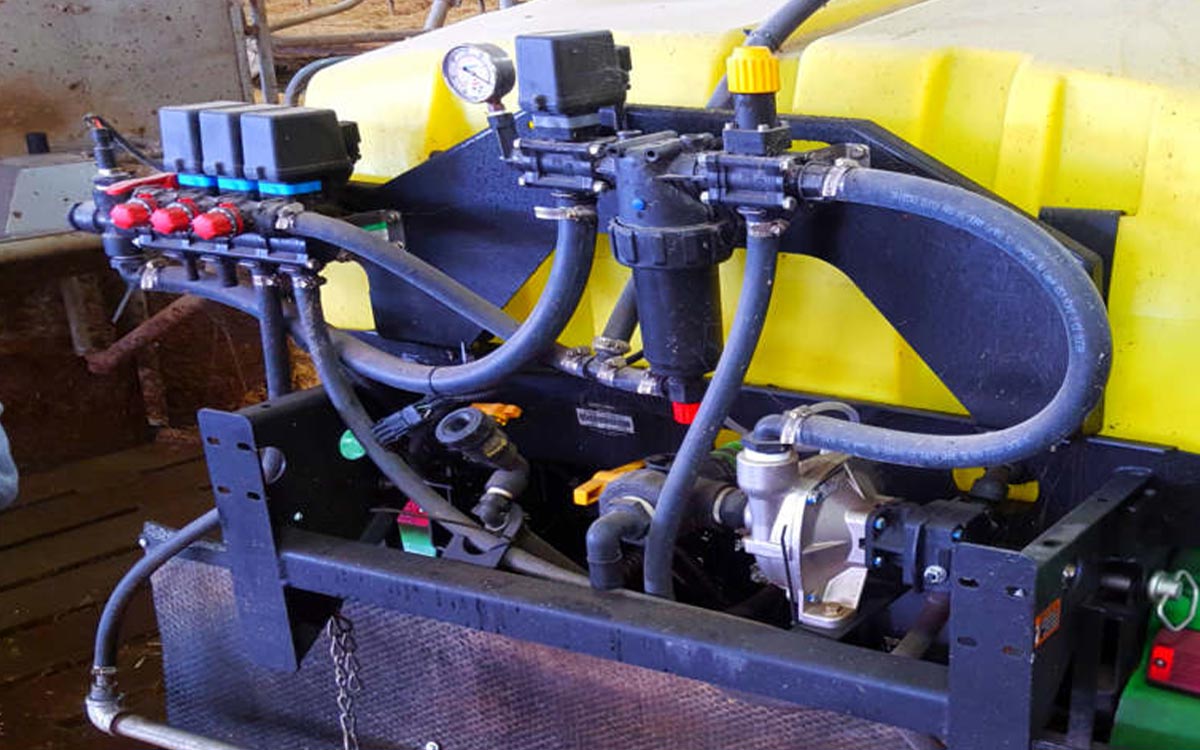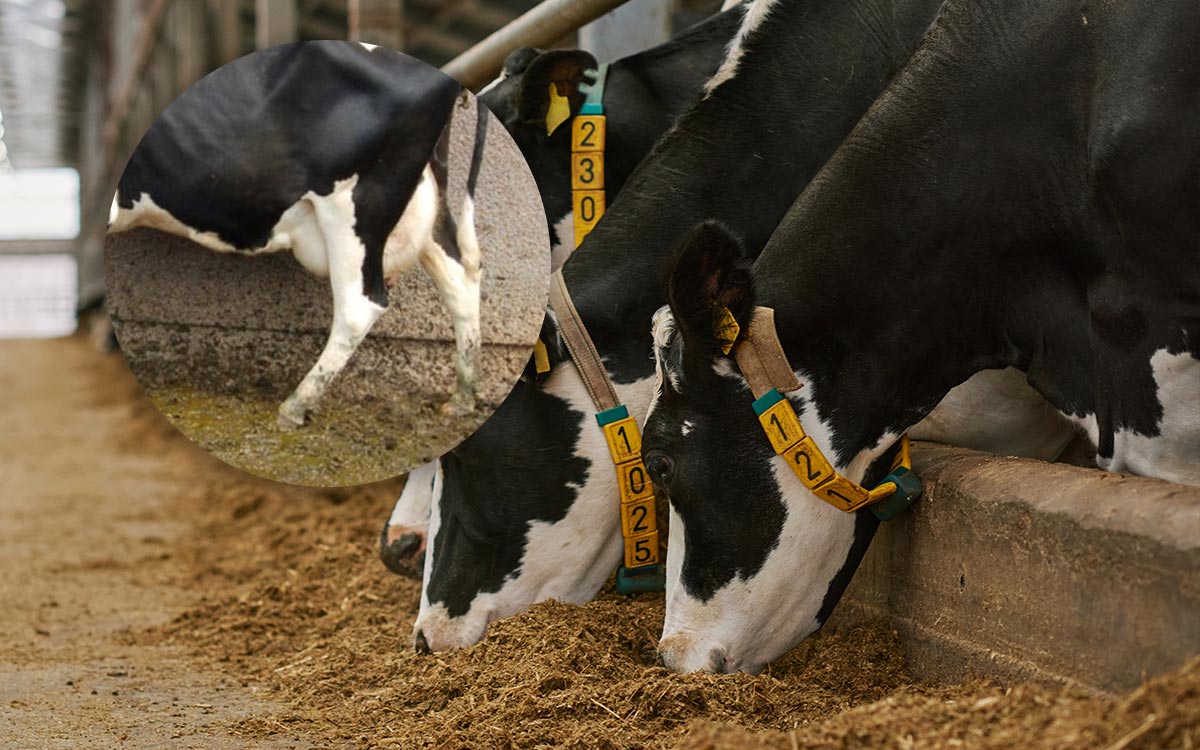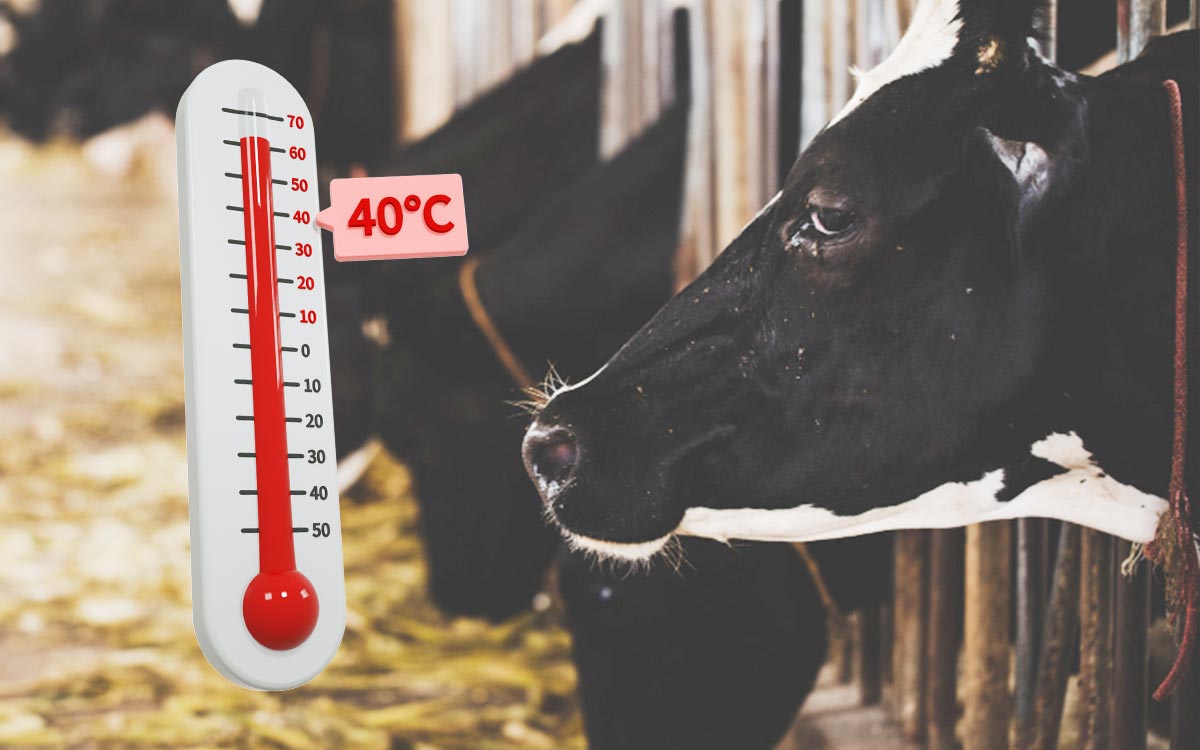Table of Contents
Caring for the hooves of your cows is a critical aspect of their overall health and well-being. Neglecting hoof care can lead to various issues, including lameness and discomfort. In this article, I will explore the importance of routine trimming, how to trim overgrown cow hooves, common mistakes to avoid, the essential supplies needed, when to seek veterinary help, and how to implement a regular hoof care routine for your bovine companions. By following these tips, you can ensure your cows have healthy, well-maintained hooves that contribute to their overall vitality.
Properly caring for overgrown cow hooves is essential. Learn about the benefits of routine trimming, avoid common mistakes, gather the correct supplies, and know when to seek professional assistance for your cattle’s hoof health.
Table of Contents
The Benefits of Routine Trimming
Regularly trimming your cows’ hooves offers many benefits for their health and productivity. A well-trimmed hoof provides proper weight distribution, reducing the risk of joint and skeletal problems. Additionally, a balanced hoof improves cows’ mobility, which, in turn, enhances their grazing and feeding habits. By ensuring your cows’ hooves are in good condition, you contribute to their overall well-being and can expect higher milk production and reproductive success. Not only does routine trimming benefit the cows, but it also has positive effects on the overall management of your farm. When cows have healthy hooves, they are less likely to experience lameness. I have often shared with my clients that it pays to trim. You’ll avoid costly treatment bills from veterinarians and hoof trimmers and increase productivity.By investing in regular hoof care, you can save both time and money in the long run.
A key aspect of routine trimming is preventing overgrown cow hooves from becoming problematic. Overgrown hooves can lead to lameness and discomfort, adversely affecting your cows’ overall health and productivity. Identifying and addressing overgrown hooves is crucial for maintaining optimal hoof condition.
One way to identify overgrown hooves is by observing the cows’ gait. If you notice abnormal walking patterns, such as limping or favouring one leg, it may indicate a case of prolonged overgrown hooves. Inspecting the hooves regularly can help you spot any signs of excessive growth, such as longer toes, misshapen hooves or higher heels.
Health and Productivity Benefits
Mobility and Feeding
Early Detection and Prevention
Economic Benefits
Addressing overgrown hooves requires proper trimming techniques and tools. It is essential to use sharp and clean trimming equipment to ensure a smooth and precise cut. Trimming should be done by a skilled professional or a trained individual who understands the anatomy of a cow’s hoof and how to trim it correctly.
Regular trimming intervals should be determined based on the individual needs of your cows. Factors such as breed, age, and environment can influence the rate of hoof growth.
Consulting with a veterinarian or an experienced hoof trimmer can help you establish a trimming schedule that suits your cows’ specific requirements. Prevention is the key to success, especially regarding hoof trimming and hoof health.
Aside from preventing overgrown hooves, routine trimming also allows for early detection and treatment of hoof-related issues. The hooves can be thoroughly examined during trimming for signs of infection, injury, or disease. Prompt identification and treatment of such problems can prevent them from escalating and causing further harm to the cows. By investing in regular hoof care, you contribute to the well-being of your cows and save time and money in the long run.
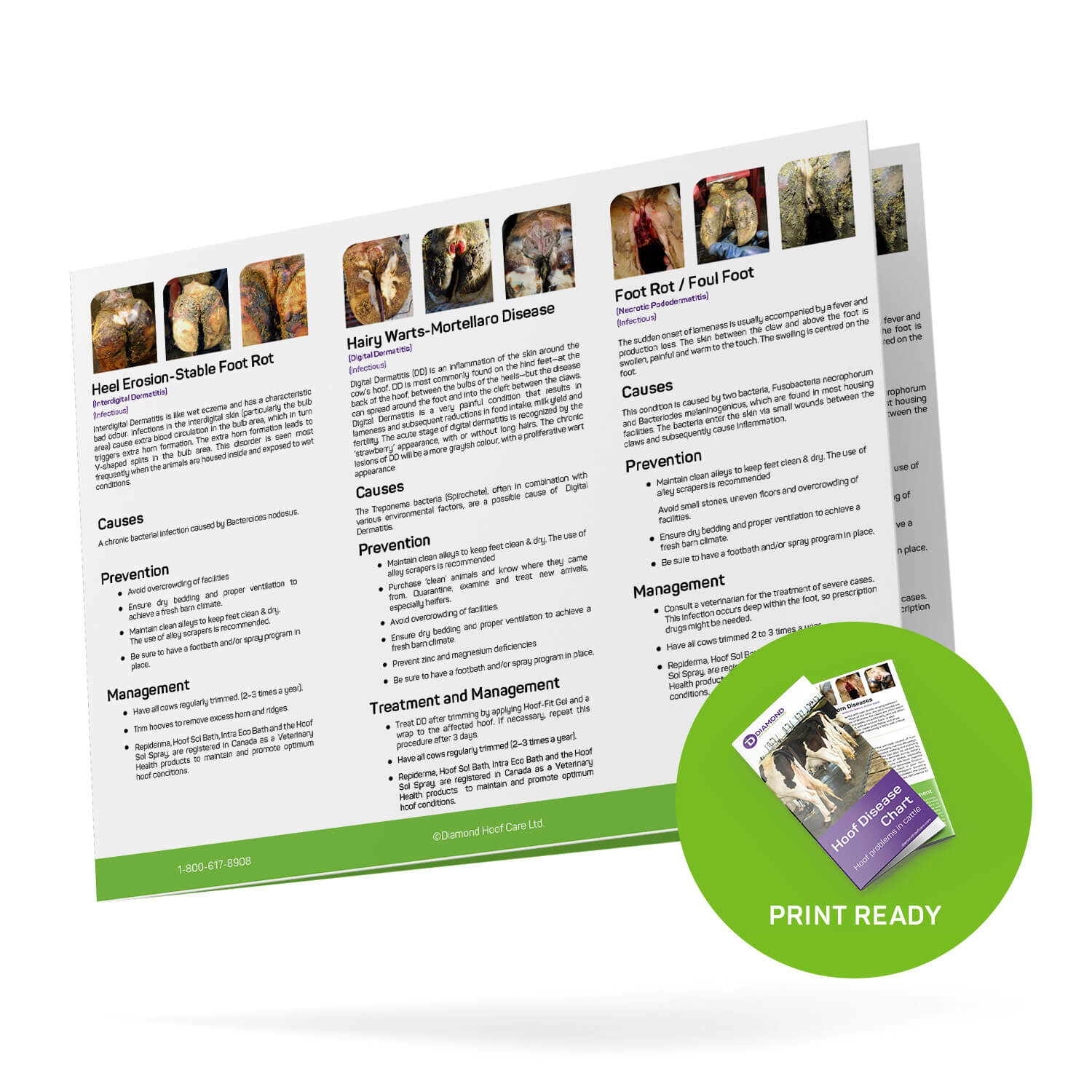
Hoof Disease Reference Chart
How to Trim Overgrown Cow Hooves
Trimming overgrown hooves is a delicate process that requires patience and precision. It is an essential aspect of cow care, as neglecting hoof health can lead to discomfort and lameness. Properly maintained hooves contribute to the overall well-being and productivity of the cow.
Before starting the trimming process, gathering all the necessary supplies is crucial. These include a sharp hoof knife, a hoof nipper and a secure place to hold the cow. During my hoof-trimming career, I have seen many inventive ways that a cow was restrained. I learned that trimming the cow in the parlour is not the right way, and we’ll be asking for an accident to get hurt ourselves. Investing in a suitable hoof trimming chute is money well spent. Having the right tools and equipment ensures that the trimming procedure is efficient and safe for both the cow and the trimmer.
Knowing the Hoof Anatomy
Furthermore, it is essential to familiarize yourself with the anatomy of a cow’s hoof. Understanding the different structures and their functions will help you identify any abnormalities or issues requiring attention during trimming. This knowledge enables you to make informed decisions and perform the trim with precision.
When trimming overgrown hooves, it is crucial to maintain a balanced hoof shape. This involves gradually bringing the hoof closer to its ideal form. Removing excess growth can restore proper weight distribution and minimize stress on the cow’s joints and ligaments—the hoof angle changes by trimming, and the weight shifts into the toe area.
It is crucial, though, to avoid trimming excessive amounts in a single session, especially on hard walking surfaces like concrete or rocky pathways. Overzealous trimming can cause pain and discomfort to the cow and leave the hoof vulnerable to infection or injury. Instead, opt for regular and conservative trimming sessions over time. This approach allows the cow’s hooves and ligaments to adapt gradually and promotes healthy hoof growth.

Image source: wavegoodbyetopain.co.uk
Horn-like Material
Complex Internal Structures
During trimming, it is also essential to assess the overall hoof health. Look for signs of infection, such as foul odour or discharge and abnormal growth patterns or lesions. Addressing these issues ASAP can prevent further complications and maintain the cow’s hoof health.
Additionally, it is worth noting that the environment in which the cow is kept can impact hoof health. Providing clean and dry bedding in correct-sized free-stalls or open housing, as well as regular access to well-maintained pasture or concrete surfaces, can contribute to the prevention of overgrown hooves. These factors help to naturally wear down the hooves and reduce the frequency of trimming required.
The art of hoof trimming overgrown cow hooves is a meticulous process that requires attention to detail. By using the right tools, understanding the anatomy of the hoof, and maintaining a balanced trimming approach, you can ensure the cow’s hoof health is optimized. Regular trimming sessions and proper environmental management contribute to the overall well-being and productivity of the cow.
Avoiding Common Hoof Care Mistakes
When it comes to hoof care, several common mistakes should be avoided to ensure the health and well-being of the animal. One of the most crucial mistakes is trimming the hooves too aggressively. While removing as much excess growth as possible may seem like a good idea, this can lead to unintended consequences. Trimming too much (called over-trimming) can result in bleeding or lameness, causing unnecessary pain and discomfort for the animal.
Proper handling and positioning of the cow during hoof trimming is also essential to avoid injuries. Improper techniques can harm the animal and put the person performing the hoof trimming at risk. It’s necessary to have a good understanding of the cow’s anatomy and behaviour to ensure a safe and effective trimming process. Learning proper handling techniques and using appropriate tools can significantly reduce the risk of accidents and injuries.
In addition to trimming mistakes, addressing hoof infections is another standard error. Overgrown hooves can create pockets where dirt and moisture accumulate, providing a perfect breeding ground for bacteria and fungi. This can lead to painful infections and other hoof-related issues. Regular inspections are crucial to identify any signs of disease early on. Appropriate treatment should be administered promptly to prevent further complications if any symptoms are detected.
Furthermore, it’s important to note that hoof care is not a one-time task but rather an ongoing process. Regular maintenance and monitoring are necessary to ensure optimal hoof health. This includes not only trimming but also proper prevention methods with hoof spraying and foot bathing, as well as providing a suitable environment for the animal to prevent excessive wear and tear.
By avoiding common hoof care mistakes and implementing proper care techniques, the overall health and well-being of the animal can be significantly improved. Taking the time to educate oneself on appropriate hoof care practices and seeking professional guidance when needed can make a significant difference in the long-term hoof health of the animal.
Essential Supplies Needed for Proper Hoof Care
Having the necessary supplies to maintain proper hoof care for your cows is essential. In addition to the tools mentioned earlier, you may also need treatment for infectious diseases, bandages, and perhaps a sturdy halter to restrain the cow’s head during hoof care procedures.
If a chore is not easy, it tends to be skipped, especially when it involves a cow’s hoof.
Investing in good-quality tools and supplies will put ‘fun’ into hoof care and contribute to the overall process’s efficiency and effectiveness. Regularly cleaning and disinfecting your tools is also critical to prevent the spread of pathogens and ensure the long-term health of your cows’ hooves.
When treating Digital Dermatitis, I use the Intra Hoof-fit Gel. This veterinary medicine has a DIN registration in Canada and many other countries. With this antibiotic-free approach, I have had great success and used it since 2006. The chelated Copper effectively kills the Treponema bacteria, and the chelated Zinc promotes the healing of the lesion.
Bandages are essential for providing prolonged contact after a treatment is applied. There are different types of wraps available. Lately, we have been using the Intra Eco Tape. For the hoof trimmer, there is no difference in how it is applied, but I can get one extra hoof out of a roll, and it’s a biodegradable wrap. Any wrap that is applied should be removed within three days.
When it comes to restraining the cow during hoof care procedures, a chute is necessary to ensure the safety of both the cow and the person performing the procedure. A hoof chute is a narrow passage or enclosure restricting the cow’s movement, making it easier to handle and work on their hooves. Chutes are commonly used in larger operations where multiple cows must be treated regularly. They provide a secure and controlled environment for hoof care procedures.
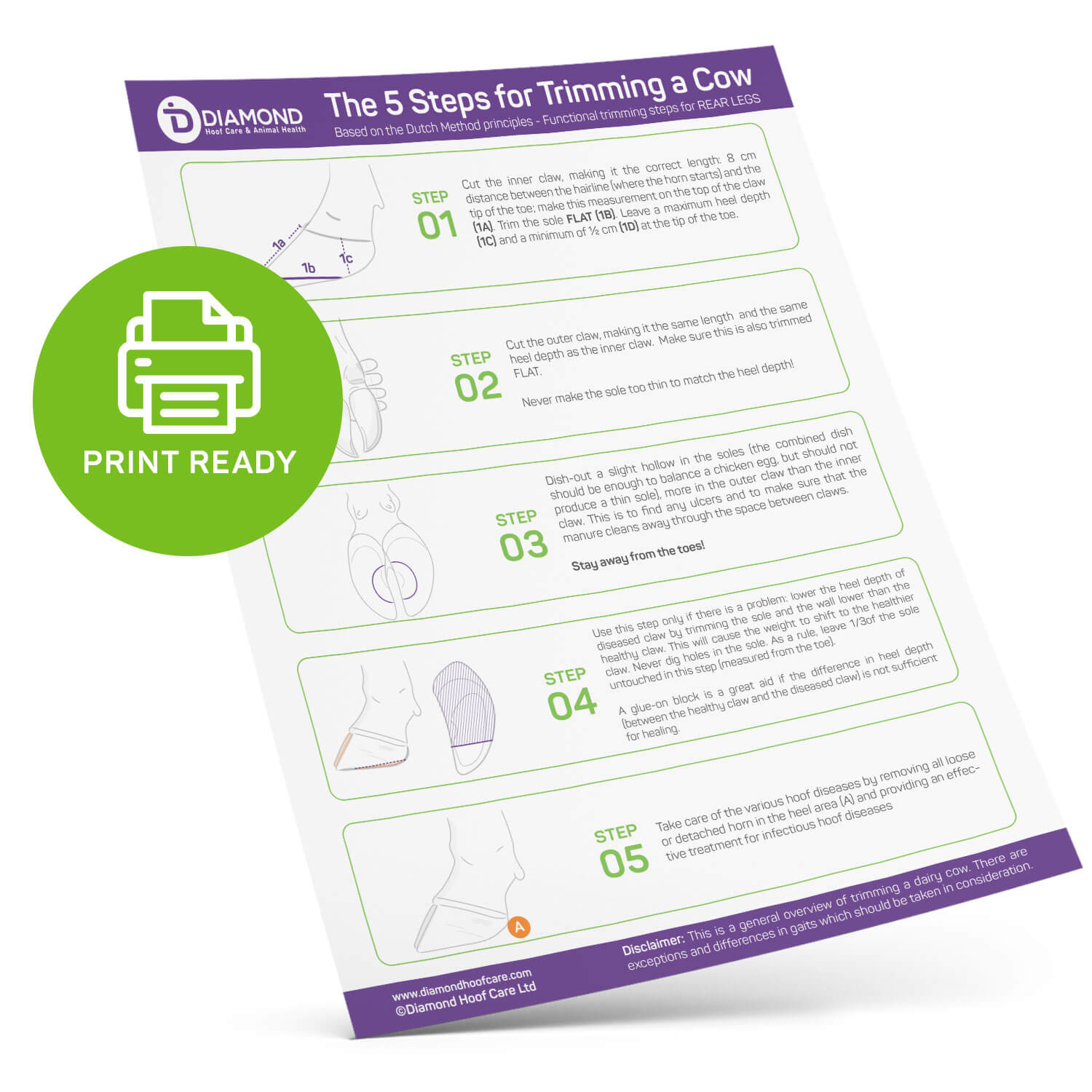
5 Steps to Trim Cheat Sheet
Signs of Trouble: When to Seek Professional Help
While routine trimming can prevent many hoof problems, there may be instances where veterinarian or hoof trimmer intervention is necessary. It’s essential to be vigilant and aware of signs that indicate trouble.
If you notice excessive limping, swelling, or bleeding, contacting your herd’s professional is critical. These symptoms may indicate infections, abscesses, or other underlying issues that require professional care. Additionally, if you are unsure about your ability to trim overgrown hooves or encounter any unexpected difficulties properly, do not hesitate to seek assistance from your hoof trimmer.
Keep an eye out for any unusual discharge or pus coming from the hooves. This could indicate an infection or abscess that needs immediate veterinary attention. Abscesses are often caused by bacteria entering the hoof through a small puncture wound or crack. They can be extremely painful and require proper drainage and treatment to prevent further complications.
Remember, your cow’s hooves are vital to their overall health and well-being. Regular hoof care and maintenance are essential, but it’s equally important to recognize when veterinary help is necessary. You can ensure your herd’s hooves remain healthy and sound by staying vigilant and seeking professional assistance.
Implementing a Regular Hoof Care Routine
Establishing a regular hoof care routine is essential for promoting the long-term health of your cows’ hooves. The following areas are examples of areas of attention:

Final Comment on Caring for Overgrown Hooves
Caring for your cows’ hooves is crucial to responsible animal husbandry. Routine trimming and the proper tools, knowledge, and preventive measures can promote optimal hoof health. Regular inspections by a professional hoof trimmer and veterinary assistance when needed are also essential.
By incorporating these practices into your farming routine, you can ensure that your cows have healthy, well-maintained hooves that positively contribute to their overall health and productivity.

